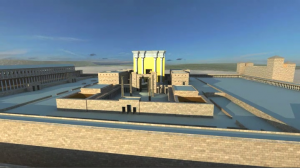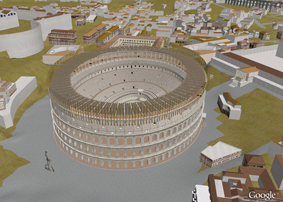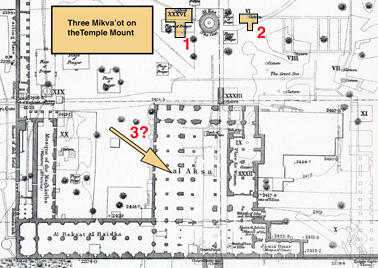During the month of March, anyone can access the ESV Study Bible for free at this website:
http://www.esvstudybible.org/online
It was a privilege to have worked on this wonderful project. This is what Justin Taylor (Project Director) wrote:
“The ESVSB was published just over four months ago and there are already 300,000 copies in print. We give God the honor and the praise, and we pray that God would use this resource to help edify and build up his church.”
Author: Leen Ritmeyer
The Antonia, Herod’s Temple Mount Fortress
In the Jan/Feb 2009 issue of Biblical Archaeology Review, an article was published by Ehud Netzer, called “A New Reconstruction of Paul’s Prison”. Netzer is a respected and successful architect/archaeologist and well-known for his excavations of Herodium and Hasmonean and Herodian Jericho and other Herodian sites. Recently he amazingly found the long-lost tomb of Herod the Great.
In the last few years he also tried, less successfully in my opinion, to reconstruct Herod’s Temple Mount. His reconstruction proposal for the Antonia Fortress is a clear example of ignoring important historical sources and archaeological evidence. Here is his reconstruction: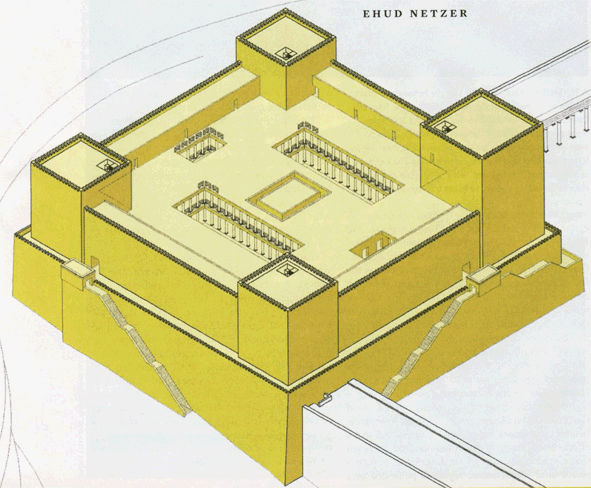
As far as historical sources are concerned, Josephus (War 5.238-246) wrote that “The tower of Antonia lay at an angle where two porticoes, the western and the northern, of the first court of the Temple met; it was built on a rock fifty cubits high and on all sides precipitous.”
The reconstruction of Netzer does not meet these two historical requirements. The northern and western porticoes don’t meet and no rockscarp is to be seen in Netzer’s drawing on the south and west sides. Indeed, there never were precipitous rockscarps in the area occupied by the southern and south-eastern part of his reconstruction.
There is archaeological evidence that the two porticoes did in fact meet. Sockets for the roof beams of the northern portico can still be seen today in the northwest corner of the Temple Mount, see Ritmeyer, The Quest, Revealing the Temple Mount in Jerusalem, p. 130), see:
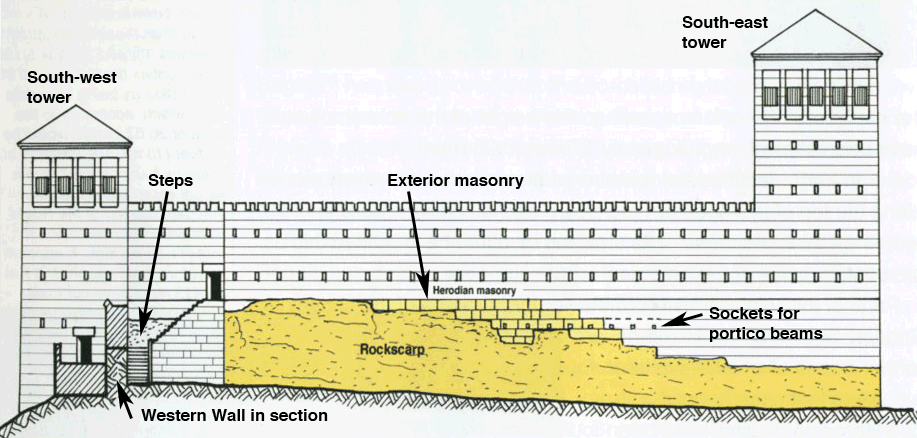
These sockets were placed in exterior Herodian masonry, which is visible high above the still-existing rockscarp. This masonry consists of ashlars with the typical Herodian margins, which were used for exterior masonry only. This proves that this rockscarp with its Herodian masonry was an external wall, namely the southern wall of the Antonia Fortress and not an interior wall. This also shows that the northern portico of the Herodian Temple Mount ran in front of the southern facade of the fortress, enabling it to “meet” with the western portico, as described by Josephus.
Netzer places the south-western corner of the fortress at small projection in the Western Wall. This projection exists, possibly because of the lay of the bedrock, but it is too insignificant a projection for the south-west tower of the Antonia. There is a much larger projection to the north, which is completely ignored by Netzer. It can be seen in the western side of the north-west corner of the Temple Mount and at the end of the Western Wall Tunnel. This projection has been mapped by Gregory Wightman (Temple Fortresses in Jerusalem, BAIAS, Vol. 10, pp. 7-35) in this diagram:
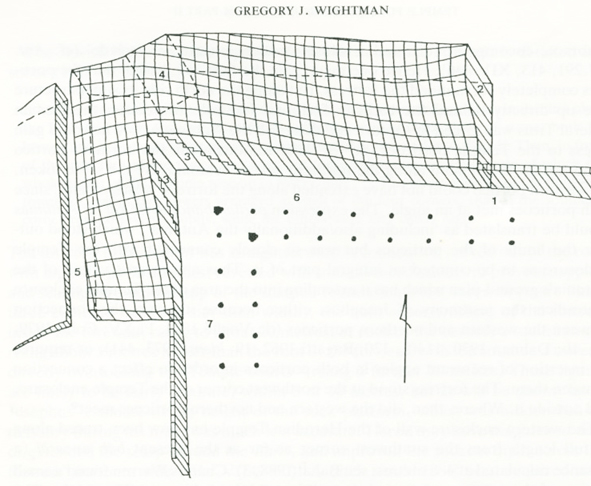
It shows that the south-west tower projected much more from the Western Wall than shown in Netzer’s reconstruction. All of these historical and archaeological data, ignored by Netzer, have been incorporated into my own reconstruction of the Antonia Fortress as shown in this model:
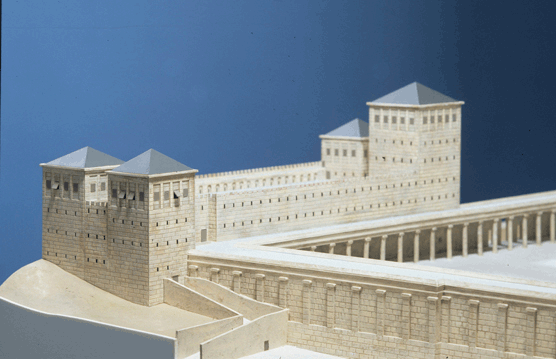
Original Herodian paving stones were, until recently, visible in the north-west corner of the Temple Mount. Netzer’s reconstruction does not relate to this pavement. Netzer’s Antonia plan is square, although the north-west corner of the Temple Mount is in fact not a right angle, but an acute angle of approximately 86 degrees.
In 1975, P. Benoit (The Archaeological Reconstruction of the Antonia Fortress, Jerusalem Revealed, 1976) has brilliantly shown that the Antonia was located exclusively on the rockscarp at the north-west corner of the Temple Mount. Prior to this time, several scholars, such as De Vogüé and Vincent, had promoted a larger Antonia which projected inside the Temple Mount. It is a pity to see that Netzer has regressed to that earlier and by now obsolete reconstruction of the Antonia Fortress.
Ivory pomegranate found in City of David excavations
Joseph Lauer passed on this interesting information:
“Dr. Eliot Braun noted on the ANE-2 list that the January 9, 2009 Ha’aretz Hebrew online edition has an illustrated report about the discovery in the City of David excavations led by Dr. Ronny Reich and Eli Shukron of a miniature ivory pomegranate and a bulla (among over 170 other bullae found in the excavations).
The article, which has not yet appeared in Ha’aretz English online edition, may be read here.
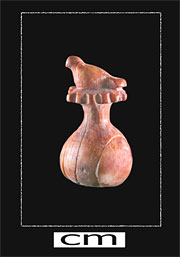
picture of the pomegranate
Also on the ANE-2 list, Dr. Victor Avigdor Hurowitz has taken issue with certain statements made in the article, including “that the pomegranate found in the City of David is similar in form to the 400 decorative pomegranates which are described in Solomon’s Temple according to the book of I Kings 7:43 (should be v. 42 and cf also v, 20!)”. Calling this “absolute nonsense”, he points out that “The pomegranates in the temple descriptions were part of the Yakhin and Boaz pillar crowns which were made of bronze and not ivory as is the new pomegranate.” With regard to the dove sitting on the pomegranate, he writes that I Kings 7 “doesn’t describe the pomegranates at all, let alone the doves on top of them, unless we somehow take hassebakah mentioned along with weharimmonim as a corruption of hassobek (dove coop).” He concludes that “At most one can say that the newly discovered pomegranate can be, like pomegranates mentioned in various biblical passages, a decorative motif known also from cultic contexts.” See here.
Additional ANE-2 postings have been made. I’m sure that many more articles and postings will follow.”
The Messiah in the Temple
The Messiah in the Temple is an exciting project with the aim of developing a 3-D visual media of the Temple of Jerusalem. This project was conceived by the project manager Martin Severin. After reading Roger Liebi’s book of that name and my book “The Quest – Revealing the Temple Mount in Jerusalem”, he decided with the help of Christof Frank of digi mice GmbH to make a digital version of the reconstructed Herodian Temple Mount.
You can read more about the project on the The Messiah in the Temple website, where you can also download a larger video file.
Thanks to Justin Taylor, you can watch the video on YouTube:
The Temple Mount and the National Geographic
In May this year, I was asked to join the National Geographic team on a poster supplement for the December Issue of the magazine. The subject of the poster was the history and architecture of the Temple Mount. I had the opportunity to meet with Fernando Baptista and Patricia Healy (NGS Senior Graphics Editor and Art Researcher respectively) in New York during a conference on “The Temple of Jerusalem: From Moses to Messiah”. See my earlier post.
They wanted my help with the creation of a NG poster on the Temple Mount and also came to see the models I had designed and which were then on show in the Yeshiva University. This interesting poster is now available in the December issue. The poster is called “Jerusalem’s Holy Ground” and shows, from top to bottom, the Binding of Isaac, The Rock, Solomon’s Temple, Herod’s Temple Mount and the Temple Mount during the Early Muslim period. It also shows cut-away drawings of Solomon’s Temple, Herod’s Temple and the Dome of the Rock and has a timeline on the side. The other side of the poster shows a magnificent map of the Eastern Mediterranean region, named “The Crucible of History”. The poster is beautifully produced and it is worthwhile getting the National Geographic December issue if you don’t have a subscription. The magazine has for its main theme, The Real King Herod, architect of the Holy Land.
Here is a view of the poster, reproduced with permission of the National Geographic Society:
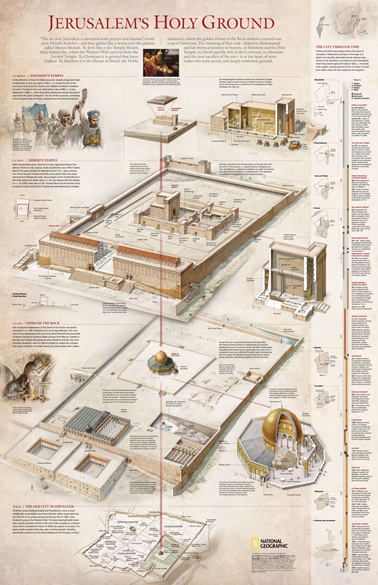
The Temple of Jerusalem and the Colosseum
One of the readers of my blog commented on an interesting connection between the Colosseum and the Temple of Jerusalem, mentioning that Prof. Louis Feldman had discovered an interesting inscription in the Colosseum in Rome. This is the stone with the inscription:
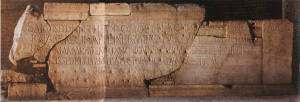
I met Prof. Feldman when I was in New York earlier this year. He did not claim to have discovered or deciphered the “ghost” inscription, for that was done by the renowned scholar Gezah Alfoldy. Feldman wrote an interesting article for BAR (July/August 2001), in which he explained how Alfoldy arrived at his conclusion. The inscription in question was carved in Latin on a stone, which is displayed in one of the entrances to the theater. This stone once carried an earlier inscription. That inscription was made of metal (probably bronze) letters which were fastened to the stone with pegs. The holes for the pegs are still visible on that stone. Alfoldy used the location of the peg holes to reconstruct the inscription and came to the conclusion that it commemorated the building of the Colosseum by Titus from the spoils of war.  Feldman then suggested that the war in question might have been the Great Jewish Revolt against Rome, which resulted in the destruction of the Temple in 70 A.D.
Feldman then suggested that the war in question might have been the Great Jewish Revolt against Rome, which resulted in the destruction of the Temple in 70 A.D.
Temple Mount Mikveh
Zachi Zweig, an archaeologist who is involved with the Temple Mount Sifting project, kindly send me the paper [in Hebrew], which he gave at the recent conference on the Temple Mount at the Bar-Ilan University. I commented on this find in an earlier post. Here is an abstract:
“Hamilton describes the discovery of a plastered cistern that was excavated below the easternmost door of the present El Aksa mosque, north of Cistern 9 [according to Warren’s numeration – see map]. The descent to [the cistern] was from west to east by means of a flight of steps, with the bottom step some 3 m. [10 feet] below the present floor of the mosque. The remains of some five steps were discerned, which were built against a plastered wall, which was about 90 cm wide [3 feet].
Unfortunately, Hamilton did not publish additional details – not one picture or plan. However, in the Mandatory Archives there was a photograph of the five steps, which descend to the opening of the cistern. The top of the steps is located some 1.50 – 2 m. [6-7.5 feet] below the present surface and to the south of it and adjacent to it, although at a little distance, there is a thick wall. This is most likely the same cistern. The steps appear to have been cut out of the rock and this points to the fact that the level of the top of the rock in this location is at about 1.50 m. [6 feet] below the level of the present pavement.”
The exit of the cistern is located deep below the level of the floor of the mosque. Hamilton dated it to the late Roman period. However, as the remains of a dividing wall can be discerned, Zachi concluded that it could have been a mikveh (Jewish ritual bath), see picture below:

It is located a little to the east of the underground passage which leads up from the Double Gate to the Temple Mount. Ronnie Reich has identified Cistern 6 and 36 as mikva’ot, but these are located in the original Square Temple Mount. These could have been added in the Second Temple period, as they are located close to the surface and no First Temple period mikva’ot are known.
This latest one, however, is located much lower down and in the Hasmonean extension of the Temple Mount and may therefore have been one of the earliest mikva’ot in Jerusalem:
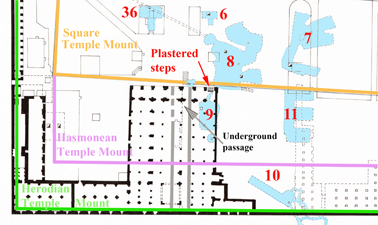 Worshipers in the Hasmonean period, who had not purified themselves before going to the Temple Mount, perhaps had the opportunity to do so in this mikveh, if it was a mikveh indeed.
Worshipers in the Hasmonean period, who had not purified themselves before going to the Temple Mount, perhaps had the opportunity to do so in this mikveh, if it was a mikveh indeed.
Jerusalem and Rome
Third Jewish Mikveh and a Byzantine Mosaic floor discovered on the Temple Mount
It was reported in the Jerusalem Post that during the recent Rennert/Bar-Ilan University’s conference on “New Studies on Jerusalem”, Zachi Zweig pointed out that during reconstruction work at the El-Aqsa mosque in the 1930’s, the remains of a Byzantine mosaic floor and a mikveh (Jewish ritual bath) were discovered. The mikveh was located below the Byzantine floor.
This is an important discovery and will change our views on the history of the Temple Mount. The mosaic floor may or may not have belonged to a church. More information is necessary before deductions can be made about the nature of the building, but the mosaic pattern possibly indicates a public building.
The mikveh would be the third we know of on the Temple Mount, as two other ones have been identified previously by Ronnie Reich. He based his proposal on the shape of the shape of Cisterns 6 and 36 (1 and 2 on Warren’s map of the Temple Mount below). The exact location of the newly published mikveh (3) inside the El-Aqsa mosque is not yet known. However, this nevertheless proves the Jewish origin of the Temple Mount.
Source: Joe Lauer
First Temple Period Hebrew Seal found
It is always exciting when an Hebrew seal of the 7th Century B.C. is found, as announced today here. In an excavation 100 m west of the Western Wall an impressive seal was found. It shows a Hebrew archer in Assyrian style military outfit and his name, Hagab, engraved in ancient Hebrew script next to him. At least he doesn’t look like a grasshopper, which the Hebrew meaning of this name is. The name appears in reverse, so that it would come out right, when impressed in clay.
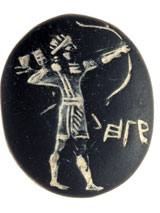
It was stated that this name of Hagab also appears in the Bible, namely in Ezra 2.46. That is where the comparison ends, of course, for this Hagab was one of the Nethinim, temple servants. Temple servants were not usually dressed in warrior’s suits.
The seal was found in an excavation, located some 100 m. from the Western Wall. This wall, of course, did not exist at the end of the First Temple period. The Western wall at the end of the First Temple period was located at least 25 m further to the east. That wall was part of the 500 cubit square Temple Mount, which was probably built a century earlier by King Hezekiah.

